The world is witnessing a significant shift towards renewable energy sources, with solar generators emerging as a viable alternative to traditional fossil fuel generators.
As the demand for sustainable and portable power solutions grows, solar generators have become increasingly efficient and affordable, making them an attractive option for various applications, from emergency backup to outdoor recreation and off-grid living.
These portable power stations are powered by solar panels and offer a reliable source of energy, with their capacity and battery chemistry being key factors in determining their suitability for specific needs.
Key Takeaways
- Discover the benefits of using solar generators for off-grid power.
- Learn how to assess the capacity and battery chemistry of solar generators.
- Understand the advantages of solar generators over traditional fossil fuel generators.
- Explore the various applications of solar generators.
- Find out how to choose the right solar generator for your specific needs.
Understanding Solar Generators: The Basics
https://www.youtube.com/watch?v=3AxHzrgf4SI
As we explore the world of renewable energy, understanding the fundamentals of solar generators becomes increasingly important. Solar generators are revolutionising the way we think about power generation, offering a clean, portable, and efficient alternative to traditional energy sources.
What Is a Solar Generator?
A solar generator is essentially a portable power storage system that is powered by solar panels. Unlike solar-plus-storage systems designed for home backup, solar generators are designed to be portable and do not require professional installation. This portability makes them ideal for various applications, from camping to providing emergency power during outages.
How Solar Generators Work
Solar generators work by capturing sunlight through solar panels and converting it into electrical energy. This energy is then stored in a battery system for later use. The process involves several key components working together to provide a reliable source of power.
Components of a Solar Generator System
The core components of a solar generator system include:
- Photovoltaic panels that capture sunlight and convert it into electrical energy.
- A charge controller that regulates the power input to the battery.
- A battery storage system that stores the generated energy for later use.
- An inverter that converts DC electricity to AC for powering devices.
Modern solar generators employ sophisticated technology to maximise energy capture and storage efficiency. The portability of these systems distinguishes them from fixed solar installations, allowing users to transport their power source as needed.
Why Choose a Solar Generator for Off-Grid Power?
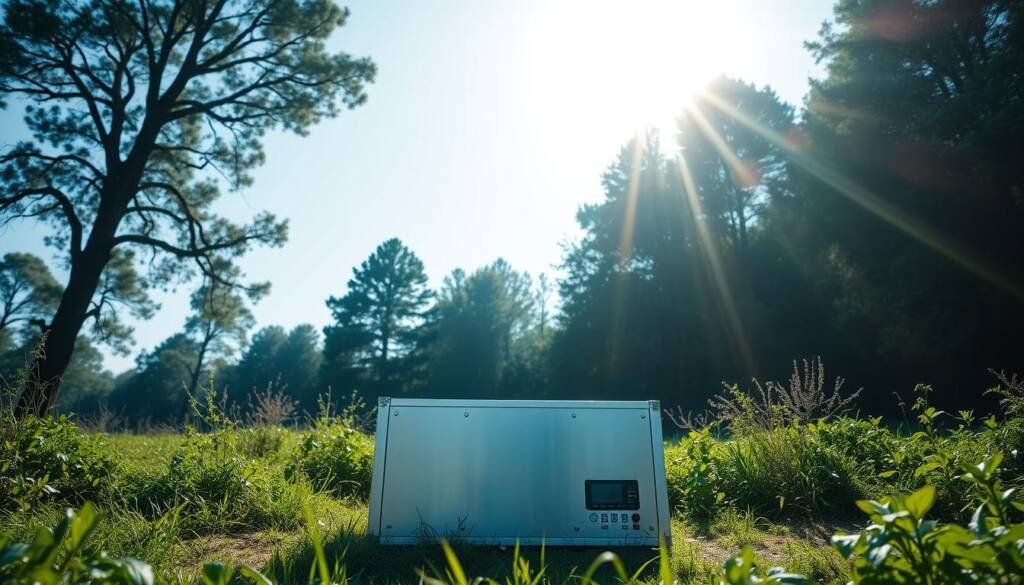
The benefits of choosing a solar generator for off-grid power are multifaceted and significant. As we explore the advantages, it becomes clear why solar generators are an attractive option for those seeking independence from the grid.
Environmental Benefits
Solar generators represent a significant step towards sustainable living, offering a clean energy alternative that produces zero emissions during operation. Unlike traditional fossil fuel generators, solar generators harness the sun’s energy, providing a renewable source of power.
- Zero emissions during operation, reducing carbon footprint
- No fuel storage or oil changes required, minimizing environmental impact
- Renewable energy source, decreasing reliance on fossil fuels
Cost Efficiency Over Time
The initial investment in a solar generator is offset by long-term savings. Users benefit from free energy from the sun throughout the lifespan of the equipment, eliminating ongoing fuel costs. This makes solar generators a cost-efficient option over time.
Quiet and Clean Operation
Solar generators operate silently, making them ideal for camping, outdoor events, and residential areas where noise pollution is a concern. Their clean operation also ensures that they do not contribute to air pollution, providing a healthier environment.
In conclusion, the advantages of choosing a solar generator for off-grid power include environmental benefits, cost efficiency, and quiet and clean operation. As the world continues to shift towards renewable energy sources, solar generators are poised to play a significant role in meeting our power needs sustainably.
Types of Solar Generators
With the increasing demand for renewable energy solutions, solar generators have evolved into several distinct categories. These categories cater to various needs, from portable power solutions to comprehensive home backup systems.
Understanding the different types of solar generators is crucial for selecting the most appropriate one for your needs. The primary categories include portable solar generators, home backup solar generators, off-grid solar generator systems, and hybrid solar generators.
Portable Solar Generators

Portable solar generators represent the most versatile category, designed for mobility and ease of transport. They are ideal for camping, outdoor events, and emergency situations where power needs to be readily available and transportable.
Home Backup Solar Generators
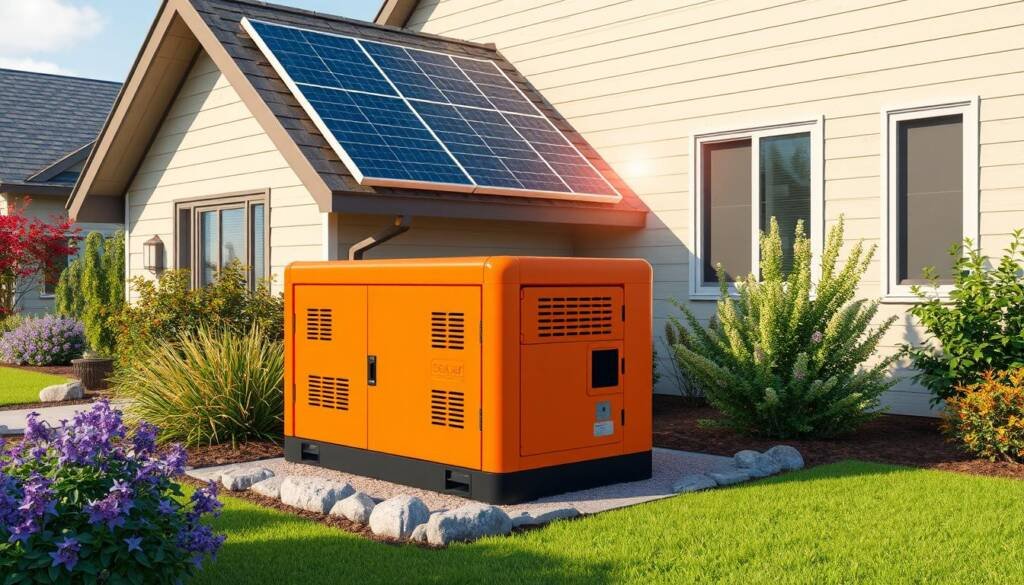
Home backup solar generators are typically larger units with higher capacity, designed to provide critical power to essential home circuits during grid outages. They offer peace of mind during severe weather events or unexpected power disruptions.
Off-Grid Solar Generator Systems
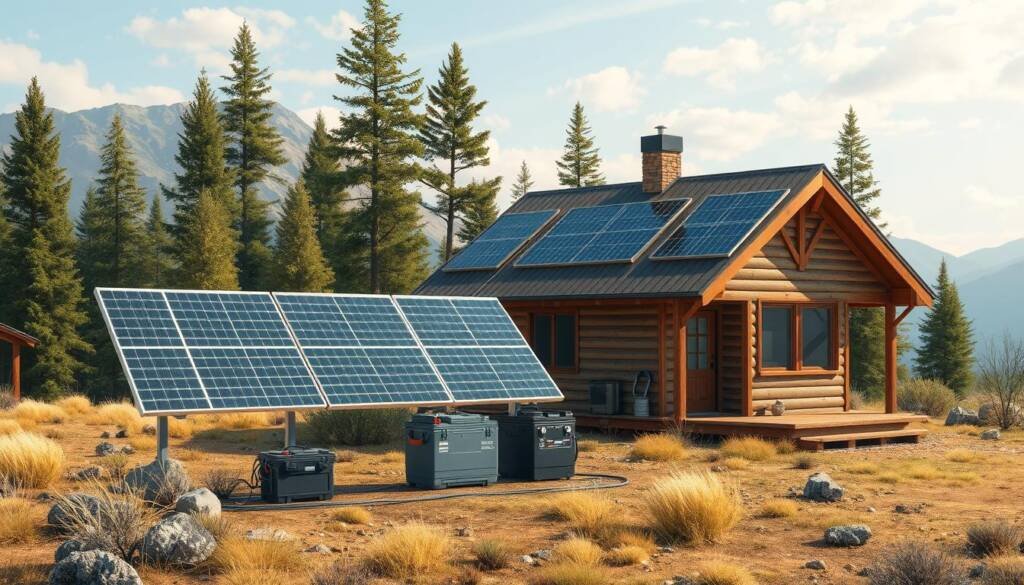
Off-grid solar generator systems are comprehensive power solutions designed for locations without access to utility power. They often feature expandable battery capacity and higher wattage outputs to support sustained living requirements.
Hybrid Solar Generators
Hybrid solar generators combine solar charging capabilities with alternative charging methods, such as wind or conventional fuel sources. This provides redundancy and reliability in various environmental conditions.
The choice between these types depends largely on intended use, with considerations for power requirements, mobility needs, and available sunlight being crucial factors in the decision-making process.
Key Specifications to Consider When Buying a Solar Generator
When investing in a solar generator, understanding the key specifications is crucial for making an informed decision. The right solar generator can provide reliable off-grid power, but its effectiveness depends on several critical factors.
Battery Capacity (Watt-Hours)
Battery capacity, measured in watt-hours (Wh), is a critical specification as it determines how much energy your solar generator can store. A higher capacity means your devices can be powered for longer before recharging is necessary.
Power Output (Watts)
The power output, measured in watts (W), indicates the amount of power the generator can deliver at once. Higher wattage generators can run more power-hungry appliances like refrigerators or air conditioners.
Solar Panel Efficiency
Solar panel efficiency directly impacts how quickly your generator can recharge when exposed to sunlight. Higher efficiency panels convert more sunlight into usable electricity, even in less-than-ideal conditions.
Charging Options and Speed
Modern solar generators offer multiple charging options beyond solar panels, including AC wall outlets and car chargers. The charging speed is crucial for users who need to quickly replenish their power supply.
Battery Chemistry and Lifespan
The battery chemistry significantly affects performance, with lithium iron phosphate (LiFePO4) batteries offering longer lifespans and better safety profiles than older nickel-manganese-cobalt (NMC) batteries.
Portability and Weight
Portability considerations include not just weight but also dimensions and handle design. Larger capacity generators can weigh 30+ pounds, making portability an important factor.
The balance between capacity and portability represents one of the most important trade-offs when selecting a solar generator. By carefully evaluating these key specifications, you can choose a solar generator that meets your power needs efficiently.
Understanding Solar Generator Metrics
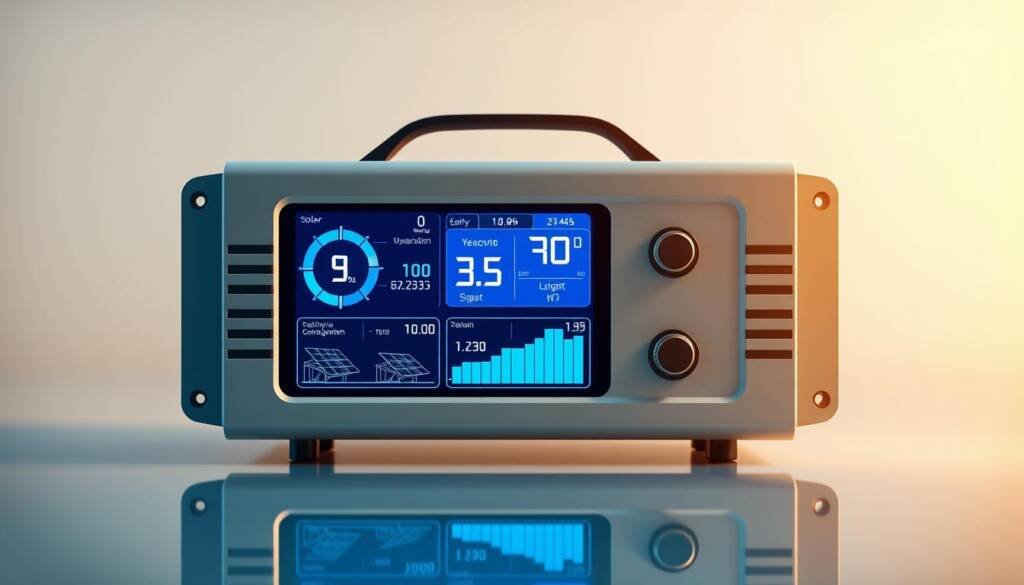
When evaluating solar generators, understanding the key metrics is crucial for making an informed decision. The performance and capabilities of a solar generator are defined by several technical specifications that can significantly impact its suitability for various applications.
Watts vs. Watt-Hours Explained
The distinction between watts (W) and watt-hours (Wh) is fundamental when assessing solar generators. Watts represent the instantaneous power output capacity, while watt-hours indicate the total energy storage capacity over time. For instance, a 1,000-watt generator can power a 1,000-watt appliance, whereas a 1,000 watt-hour battery can run that same appliance for one hour or a 100-watt device for 10 hours.
Battery Types and Chemistry Differences
Battery chemistry significantly impacts the performance and lifespan of a solar generator. Lithium iron phosphate (LiFePO4) batteries, for example, typically offer 3,000-5,000 charge cycles, compared to 500-1,000 cycles for standard lithium-ion batteries, although at a higher initial cost.
Charge Controllers: MPPT vs. PWM
Charge controllers play a crucial role in regulating the power output from solar panels to the battery. Maximum Power Point Tracking (MPPT) controllers offer 20-30% more efficiency than Pulse Width Modulation (PWM) controllers, particularly in variable light conditions. Understanding these technical metrics enables consumers to make more informed comparisons between different solar generator models.
- Understanding watts and watt-hours is crucial for evaluating a solar generator’s capability.
- Battery chemistry affects performance and lifespan, with LiFePO4 offering more charge cycles.
- MPPT charge controllers provide better efficiency than PWM controllers, especially in variable light.
Top Solar Generators for Off-Grid Living in 2025
In 2025, the market is witnessing a surge in high-quality solar generators designed to cater to diverse off-grid power requirements, making it an ideal time to invest in renewable energy. The following are some of the top solar generators that stand out for their performance, features, and reliability.
Goal Zero Yeti 1500X

Specifications and Features
The Goal Zero Yeti 1500X is a powerhouse in the world of solar generators, boasting a 2,000W output and a 1,516Wh storage capacity. Its Lithium Nickel Manganese Cobalt Oxide (NMC) battery chemistry ensures reliable performance. The device is equipped with multiple ports, including 2 USB-A, 18W USB-C, 60W USB-C PD, 6mm, 12V, 12V Power Port, and 2 120V AC Inverter, making it versatile for various applications.
Best Use Cases
This solar generator is ideal for extended camping trips, small cabin power needs, and emergency backup situations. Its comprehensive port selection allows users to charge a wide range of devices simultaneously.
Pros and Cons
The Goal Zero Yeti 1500X excels in build quality and ecosystem integration, offering a seamless user experience. However, its premium pricing may be a consideration for some buyers.
Jackery Explorer 1000

Specifications and Features
The Jackery Explorer 1000 is a popular mid-range option, featuring a 1,000W output and a 1,002Wh capacity. It is lightweight, weighing just 22 pounds, and includes 2 USB-C ports with PD, 1 USB-A port, one quick charge 3.0 port, 3 110 Volt AC wall outlets, and one 12V DC outlet.
Best Use Cases
This portable power station is perfect for weekend adventures, emergency backup, and outdoor activities where mobility is key.
Pros and Cons
The Jackery Explorer 1000 strikes an excellent balance between portability and functionality. While it may not offer the highest capacity, its user-friendly design and reasonable pricing make it an attractive option.
BLUETTI AC200P

Specifications and Features
The BLUETTI AC200P stands out with its superior Lithium Iron Phosphate (LFP) battery chemistry, offering a 3,500+ lifecycle rating, 2,000W output, and 2,000Wh capacity. It features 6 120V AC outlets, 1 12V/25A RV port, 2 15W wireless pads, 1 PD 60W USB-C, 4 USB-A, 1 12V/10A car port, and 2 12V/3A ports.
Best Use Cases
This solar generator is designed for serious off-grid applications, providing a durable and long-lasting power solution.
Pros and Cons
The BLUETTI AC200P offers exceptional battery longevity and performance. Its higher price point is justified by its extended lifecycle and robust features.
EcoFlow Delta Max (2000)
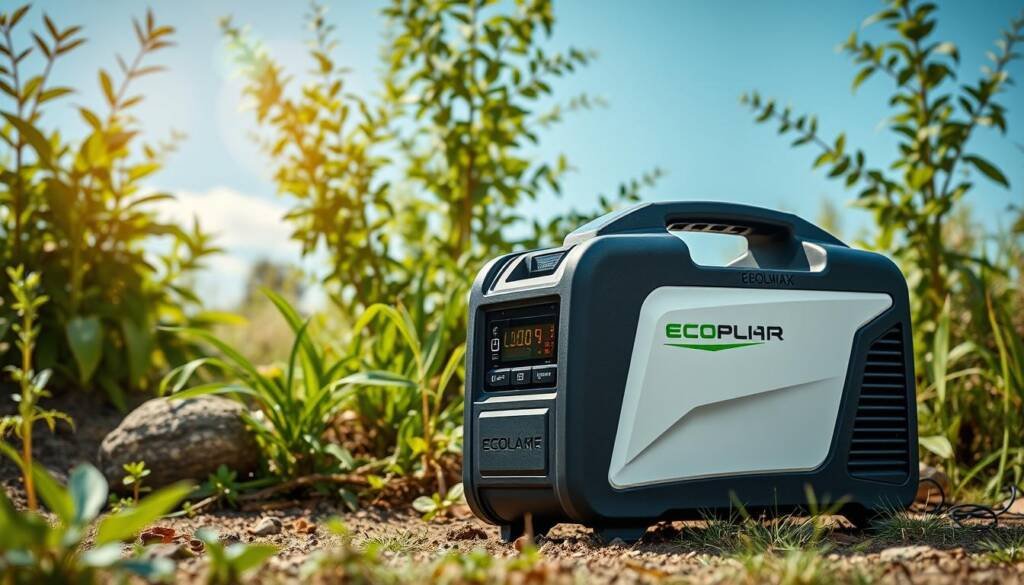
Specifications and Features
The EcoFlow Delta Max has revolutionised charging speed with its X-Stream technology, allowing 0-80% charging in under an hour. It delivers an impressive 3,400W output and has a 2,016Wh capacity. The device includes multiple output ports: USB-A, USB-C, DC, and Car Power Output.
Best Use Cases
Ideal for users who need quick turnaround between power sessions, this solar generator is suitable for off-grid living, RV use, and emergency backup.
Pros and Cons
The EcoFlow Delta Max excels in charging speed and power output. However, users should consider its size and weight when planning for portability.
Renogy Lycan 5000 Power Box
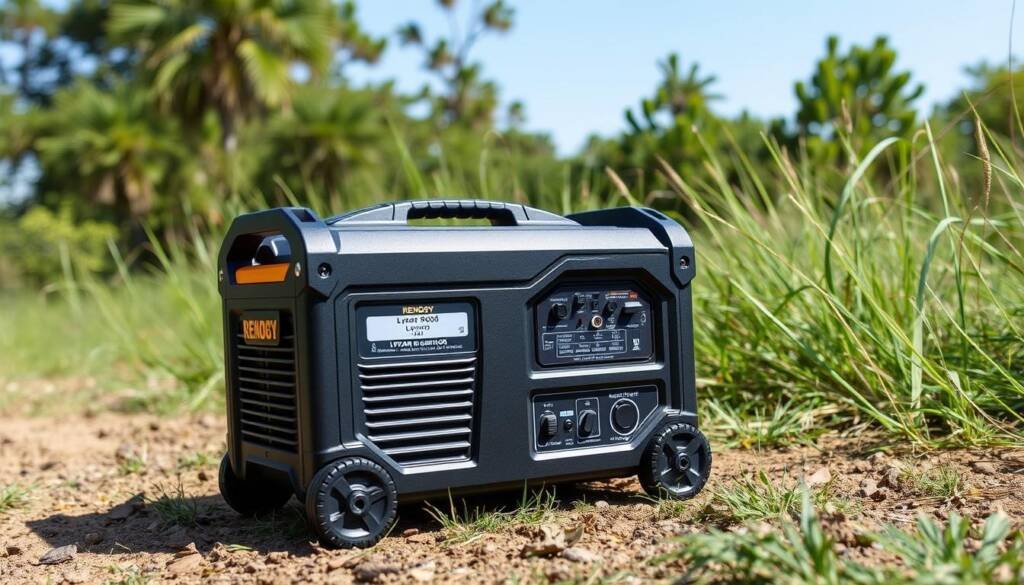
Specifications and Features
Renogy’s Lycan 5000 Power Box represents the high-capacity end of the market with its 3,500W output capability. It is designed for dedicated off-grid living situations, offering robust power management features.
Best Use Cases
This solar generator is best suited for users requiring high-capacity power solutions for extended periods or heavy-duty applications.
Pros and Cons
The Renogy Lycan 5000 Power Box offers raw power capacity, making it ideal for demanding off-grid needs. Its higher price point positions it as a premium solution.
Each of these top models offers distinct advantages, whether it’s build quality, portability, battery longevity, charging speed, or raw power capacity. When selecting a solar generator, it’s crucial to consider your specific needs and preferences to choose the best fit.
Best Solar Generators for Different Scenarios
The versatility of solar generators makes them suitable for a wide range of applications, from camping to home backup power. Different scenarios demand different specifications and features in a solar generator.
Best for Camping and Outdoor Activities

For camping and outdoor activities, lightweight and portable solar generators are ideal. Models like the Jackery Explorer 1000 and Goal Zero Yeti 500X offer the perfect balance of power capacity and portability, making them suitable for charging devices and running small appliances during weekend trips.
Best for RV and Van Life

RV and van life enthusiasts require more substantial power solutions. The BLUETTI AC200P and EcoFlow Delta Max are excellent choices, providing sufficient capacity (2,000Wh+) to power refrigerators, laptops, and other essentials for extended periods. They also offer multiple charging options, including vehicle alternator connections.
Best for Home Backup Power
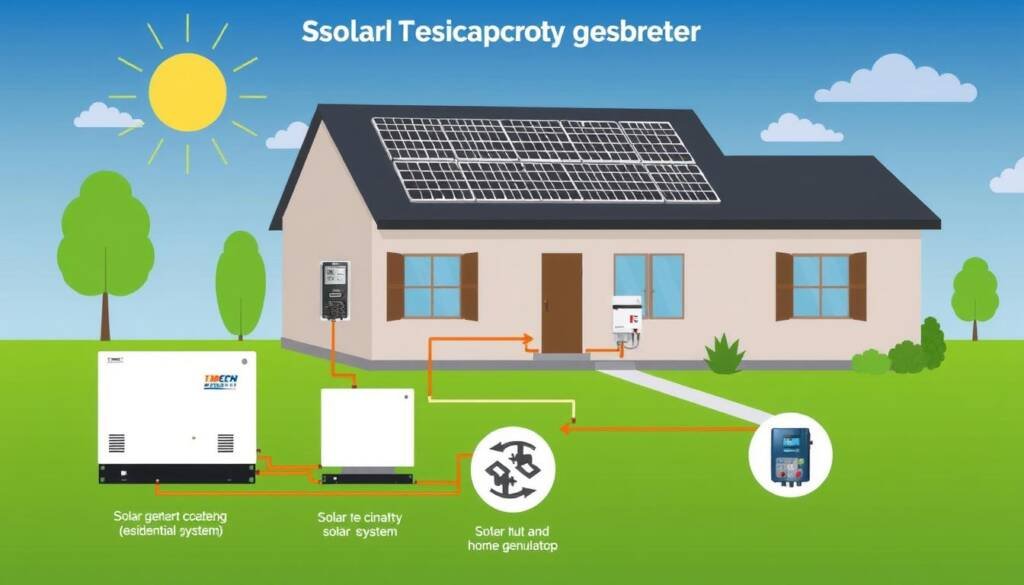
For home backup power scenarios, the highest capacity and output are required. Models like the EcoFlow Delta Pro and Bluetti EP500 are designed to provide multi-day power for essential home circuits during outages. Their expandable capacity options can be chained together to meet specific needs.
Best Budget-Friendly Options

Budget-conscious consumers can find reliable options under £500. The Jackery Explorer 500 and Anker PowerHouse II are capable of delivering performance for basic needs, although with some compromises in capacity and charging speed.
In 2025, manufacturers have developed specialised models targeting specific use cases, resulting in better-optimised products for each scenario. Whether you’re looking for a solar generator for camping, RV life, home backup, or budget-friendly options, there’s a suitable solution available.
Solar Generator vs. Traditional Generators
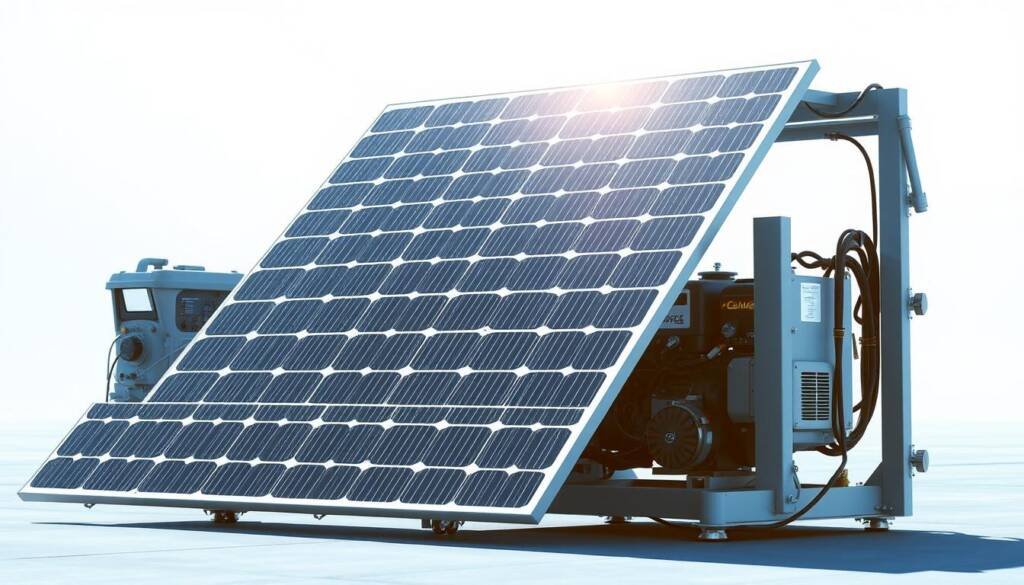
As we explore alternative energy sources, understanding the differences between solar generators and traditional generators becomes increasingly important. The decision between these two options hinges on various factors, including performance, environmental impact, and cost.
Performance Comparison
Traditional generators typically offer higher continuous power output compared to similarly priced solar generators, making them more suitable for high-wattage appliances and tools requiring sustained operation. However, solar generators excel in maintenance requirements, boasting no moving parts and significantly lower lifetime maintenance costs.
Environmental Impact
The environmental impact difference is substantial. Traditional generators produce noise pollution, carbon emissions, and potential fuel spills, whereas solar generators operate silently with zero emissions during use, harnessing energy from the sun.
Cost Analysis: Upfront vs. Long-term
The cost analysis reveals a clear pattern: traditional generators have lower upfront costs but higher ongoing expenses through fuel purchases and maintenance. In contrast, solar generators require larger initial investments but minimal operational costs over their lifespan, making them a cost-effective option in the long run.
Ultimately, the choice between a solar generator and a traditional generator depends on your specific needs and priorities. By considering factors such as power requirements, environmental concerns, and budget, you can make an informed decision that suits your lifestyle and preferences.
Setting Up Your Solar Generator System
A well-designed solar generator system can provide reliable off-grid power, but it all starts with the right setup. When configuring your system, several key factors come into play to ensure you maximise your energy generation and utilisation.
Location Considerations
Choosing the right location for your solar panels is crucial. Consider the sun’s exposure and your home’s orientation. For long-term solar power systems, an area with strong solar exposure, such as on the roof or in the backyard, is ideal. South-facing placement at a 30-45 degree angle typically provides the best year-round solar exposure in the Northern Hemisphere.
Connecting Solar Panels
To install a solar generator, you first need to connect the panels to the generator. Ensure you match the voltage requirements specified by the manufacturer to avoid damaging the charge controller or resulting in inefficient charging. Most modern solar generators feature MC4 connectors, but verify compatibility before purchase.
Battery Management Best Practices
Effective battery management is vital for maximising the lifespan of your solar generator system. Avoid complete discharge cycles, store at 50-80% charge during inactivity, and keep the unit in moderate temperatures. This helps in maintaining the health of your battery and ensuring reliable power output.
Expanding Your System
Many premium solar generators offer expansion capabilities through additional battery packs or increased solar input. This allows users to scale their system as power needs grow. When setting up, consider future expansion needs to make sure your system remains adaptable.
By carefully considering these factors and following best practices, you can create a robust and efficient solar generator system that meets your off-grid power needs effectively.
Maintenance and Care for Solar Generators
The longevity and effectiveness of your solar generator depend on proper care and maintenance. Regular maintenance not only ensures optimal performance but also extends the lifespan of your solar generator system.
Cleaning Your Solar Panels
Keeping solar panels clean is crucial for maintaining their efficiency. Dirt and debris can significantly reduce the amount of power generated. Use a soft cloth with mild soap and water to clean the panels, avoiding abrasive materials that could scratch the surface.
Battery Maintenance Tips
Proper battery care involves maintaining the right charge levels. Avoid letting lithium batteries remain at 0% or 100% charge for extended periods, as this can accelerate degradation. Instead, aim to keep batteries between 20-80% charged for the longest lifespan.
Inspecting Connections and Wiring
Regularly inspect all connections and wiring for signs of corrosion, loose fittings, or damage. This is particularly important for systems used in outdoor environments where exposure to elements can accelerate wear.
Seasonal Adjustments
Seasonal considerations include adjusting the angle of your solar panels to optimise energy capture throughout the year. Steeper angles in winter and flatter angles in summer can significantly improve performance.
- Regularly clean your solar panels to maintain optimal charging efficiency.
- Monitor battery health and adjust charging habits accordingly.
- Inspect connections and wiring quarterly to prevent damage.
Common Challenges and Solutions
As with any technology, solar generators come with their own set of challenges that users must navigate. Understanding these challenges and their solutions is crucial for maximising the benefits of solar generators.
Dealing with Limited Sunlight
Limited sunlight is one of the biggest challenges for solar generator users, particularly during winter months or in regions with frequent cloud cover. To mitigate this, users can incorporate alternative charging methods such as wall outlets or vehicle charging when solar conditions are poor. Expanding the solar panel array beyond the minimum recommended wattage can also make a significant difference in charging capability during suboptimal conditions.
- Use alternative charging methods during poor solar conditions.
- Consider expanding your solar panel array for better performance.
Managing Power During High Demand
Managing power during high demand periods requires prioritising essential devices and understanding the power consumption of each appliance. Users should utilise the generator’s display to monitor real-time power draw and remaining capacity.
- Prioritise essential devices to manage power effectively.
- Monitor real-time power draw using the generator’s display.
Troubleshooting Common Issues
Common troubleshooting issues with solar generators include unexpectedly rapid battery depletion and failure to accept a charge from solar panels. To address these, users should check for proper connection polarity, panel damage, and ensure the charge controller hasn’t entered a protective shutdown mode.
- Check connection polarity and panel damage when troubleshooting.
- Ensure the charge controller is functioning correctly.
By understanding these common challenges and implementing the suggested solutions, users can optimise their solar generator’s performance and enjoy a reliable source of power.
Ultimate Guide to Solar Generators for Off-Grid Power 2025: Final Thoughts
As we conclude our comprehensive guide, it’s clear that solar generators have revolutionized off-grid power solutions. By 2025, these innovative systems have evolved to offer efficient power for various applications, from camping to emergency home backup.
The best solar generator for your needs depends on specific power requirements, budget constraints, and intended use. Options range from portable 500Wh units to robust 3000Wh+ power stations. When selecting a solar generator, consider factors like capacity, watts, and price. For instance, entry-level models start around £500, while premium ones with advanced features exceed £2,000.
Advancements in battery technology, such as lithium iron phosphate (LiFePO4), have improved the lifecycle rating to 3,000+ charges. To make an informed decision, assess your power needs by listing essential devices and their wattage requirements. Choose a generator with at least 20% more capacity than your calculated needs. For more information on top-rated portable power stations, visit our list of the top 10 portable power stations for RVs and motorhomes in.